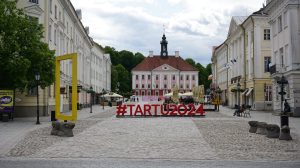Ukraine’s Chernobyl Nuclear Power Plant is still recovering from last year’s five-week occupation by Russia. But with the reception of spent nuclear fuel recently resumed, scientists at the Central Analytical Laboratory are working to restore equipment, software – and even making space plans.
As international support, Ukraine has received 23 million euros for the restoration of the Chernobyl Nuclear Power Plant (NPP) zone since the beginning of 2023 – this out of a total of 225 million euros expected from international partners. Among the main donors of the recovery project are the European Commission, the European Bank for Reconstruction and Development (EBRD), the US Department of Energy, Norway, the UK and Germany.
- Russia’s continuing stranglehold on emerging Europe’s nuclear sector
- In CEE, energy efficient buildings trump fossil fuel investment
- ‘All thunder and no lightning’: New campaign aims to speed up Europe’s fossil fuel exit
Specialists at Chernobyl NPP have restored radiation control at checkpoints, licensed the activities of enterprises for the management of radioactive waste, partially restored computer equipment, and received firefighting apparatus which will partially replace what was stolen by Russia’s forces.
In the future, the plant and surrounding territory will be entirely de-mined, while the NPP’s exclusion zone is planned to be completely reconstructed.
At the beginning of June, reception of spent nuclear fuel from nuclear power plants in Ukraine was resumed. Currently 22,645 cubic meters of radioactive waste has been accumulated in the central storage facility at Chernobyl nuclear power plant, which is equal to the volume of nine Olympic-sized swimming pools.
The centralised storage facility for spent nuclear fuel, built using technology from the American company Holtec International, was launched a few months before the Russian invasion, in late summer 2021. It will accumulate spent nuclear fuel from three Ukrainian nuclear power plants for 50 years and provide storage for 100 years.
A centre for peaceful atom research
At the same time, the central analytical laboratory resumed its work, a unique complex with powerful analytical capabilities, which can provide services at any stage of handling radioactive waste, from conditioning to burial, as well as the research and development of new technology.
The State Agency of Ukraine for Exclusion Zone Management estimates that the cost of the equipment and software that was destroyed and stolen from the laboratory during the occupation amounts to six million euros. International partner organisations are ready to help, but Ukraine is waiting for the war to end.
Despite the obstacles, scientists have continued their research, developing new theories and discussing them with the international professional community. In particular, they dream of creating a Centre for the Study of the Peaceful Atom, where various studies will be conducted: radiobiological, biological and even space.
“We have a chance, after the war is over, to make the Chernobyl zone a centre for peaceful atom research, decision-making, and implementation of new practices,” says Ruslan Strelets, Ukraine’s Minister of Environmental Protection and Natural Resources.
“We are not just talking about updating the laboratory, but about creating a new scientific platform with modern equipment and world-class specialists. Today we have all the tools to do it.”
Flights to Mars
There is also a laboratory on the territory of Chernobyl NPP which is a part of Institute of Nuclear Power Plant Safety Problems of the National Academy of Sciences of Ukraine. It is the only scientific residence of the exclusion zone.
During the Russian occupation, a large amount of equipment was destroyed. But some laboratories and equipment survived. In particular, the laboratory of Olena Parenyuk, who, together with her colleagues, studies the potential of the exclusion zone.
A radiobiologist, Parenyuk told German daily Tagesspiegel that Chernobyl is the only place on Earth where neutron radiation is recorded and there is no need to turn on a particle gas pedal.
This radiation is of low density and intensity, so according to scientists, the exclusion zone environment has ideal conditions for testing biological samples.
For more than 10 years, Parenyuk has been researching how radiation affects bacteria that live in the Chernobyl and Fukushima exclusion zones. Before the war, she and her colleagues at the Japan Atomic Energy Agency (JAEA) investigated the phenomenon of biocorrosion in Chernobyl and Fukushima.
She says her research could help explore the potential of human capabilities, particularly the human brain, with the prospect of using the information gained to prepare space expeditions.
“Space research in the exclusion zone is the future the area deserves,” she says.
According to the scientist, there are alternative options to test how neutrons affect the body and to test the hypothetical protective material. The first is to periodically send biological samples to the International Space Station (ISS). The second is placing biological samples in a particle gas pedal (hadron collider) installed in the exclusion zone.
Microorganisms live everywhere. In the spent nuclear fuel storages at Chernobyl and in the sarcophagus that encases reactor number four, which exploded in the 1986 disaster. Conditions that are unsuitable for humans are the norm for these organisms. Each repository of spent nuclear fuel has its own unique ‘microbial footprint’ – a population of microorganisms which live, feed and multiply in this very radioactive environment. The physical consequence of their metabolism is biocorrosion.

Potential donors include the ESA and NASA
“One of the main reasons why we still haven’t visited Mars is the lack of protection from cosmic radiation. Long-term neutron irradiation is very dangerous for humans. Here on Earth, we are protected by the ozone layer. While in space and on Mars we remain unprotected,” says Olena Parenyuk.
There are many entrepreneurs in the world now who are working on the development of effective protective material. Among them is an American scientist Lembit Sihver, professor of Chalmers University of Technology (Sweden).
Parenyuk is working with them on a joint project which will be implemented on the territory of Chernobyl.
The joint project of scientists has already been presented to the European Space Agency (ESA), scientists from Japan and specialists from NASA.
There is no clear date for its implementation, due to the war in Ukraine. But Chernobyl’s revival as a place of much innovation and experimentation appears to be assured.
Unlike many news and information platforms, Emerging Europe is free to read, and always will be. There is no paywall here. We are independent, not affiliated with nor representing any political party or business organisation. We want the very best for emerging Europe, nothing more, nothing less. Your support will help us continue to spread the word about this amazing region.
You can contribute here. Thank you.







Add Comment